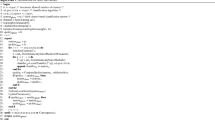Abstract
Despite recent successes and advancements in artificial intelligence and machine learning, this domain remains under continuous challenge and guidance from phenomena and processes observed in natural world. Humans remain unsurpassed in their efficiency of dealing and learning from uncertain information coming in a variety of forms, whereas more and more robust learning and optimisation algorithms have their analytical engine built on the basis of some nature-inspired phenomena. Excellence of neural networks and kernel-based learning methods, an emergence of particle-, swarms-, and social behaviour-based optimisation methods are just few of many facts indicating a trend towards greater exploitation of nature inspired models and systems. This work intends to demonstrate how a simple concept of a physical field can be adopted to build a complete framework for supervised and unsupervised learning methodology. An inspiration for artificial learning has been found in the mechanics of physical fields found on both micro and macro scales. Exploiting the analogies between data and charged particles subjected to gravity, electrostatic and gas particle fields, a family of new algorithms has been developed and applied to classification, clustering and data condensation while properties of the field were further used in a unique visualisation of classification and classifier fusion models. The paper covers extensive pictorial examples and visual interpretations of the presented techniques along with some comparative testing over well-known real and artificial datasets.









Similar content being viewed by others
Notes
University of California Repository of Machine Learning Databases and Domain Theories, available free at: ftp.ics.uci.edu/pub/machine-learning-databases
References
Wheeler JA (1989) Information, physics, quantum: the search for links. Proc of the Workshop on Complexity, Entropy, and the Physics of Information. Santa Fe 3–28
Klir GJ, Folger TA (1988) Fuzzy sets, uncertainty, and information. Prentice-Hall International Edition
Zurek WH (1989) Complexity, entropy and the physics of information. Proc of the Workshop on Complexity, Entropy, and the Physics of Information. Santa Fe
Hochreiter S, Mozer MC (2000) An electric approach to independent component analysis. Proc of the 2nd International Workshop on Independent Component Analysis and Signal Separation, Helsinki 45–50.
Principe J, Fisher I, Xu D (2000) Information theoretic learning. In: Haykin S (ed) Unsupervised adaptive filtering. New York
Torkkola K, Campbell W (2000) Mutual information in learning feature transformations. Proc of International Conference on Machine Learning, Stanford
Torkkola K (2001) Nonlinear feature transforms using maximum mutual information. Proc of IJCNN’2001, Washington DC, USA
Shawe-Taylor J, Cristianini N (2004) Kernel methods for pattern analysis. Cambridge University Press
Duda RO, Hart PE, Stork DG (2001) Pattern classification. John Wiley & Sons, New York
Feynman RP, Leighton RB, Sands M (1963) The Feynman lectures on physics. Addison Wesley
Cunningham SJ, Humphrey MC, Witten IH (1996) Understanding what machine learning produces part 2: Knowledge visualisation techniques
Ho TK (2002) Mirage—A tool for interactive pattern recognition from multimedia data. Proc of the Astronomical Data Analysis Software & Systems XII, Baltimore, MD
Kittler J (1998) Combining classifiers: a theoretical framework. Pattern Anal Appl 1:18–27
Girolami M, He C (2003) Probability density estimation from optimally condensed data samples. IEEE Trans Pattern Anal Machine Intell 25(10):1253–1264
Author information
Authors and Affiliations
Corresponding author
Rights and permissions
About this article
Cite this article
Ruta, D., Gabrys, B. A framework for machine learning based on dynamic physical fields. Nat Comput 8, 219–237 (2009). https://doi.org/10.1007/s11047-007-9064-6
Received:
Accepted:
Published:
Issue Date:
DOI: https://doi.org/10.1007/s11047-007-9064-6




